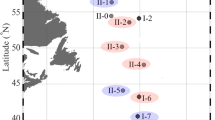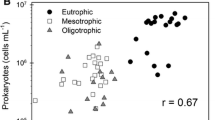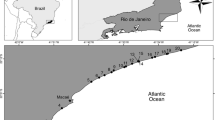Abstract
In aquatic ecosystems, fluctuations in environmental conditions and prokaryotic host physiological states can strongly affect the dynamics of viral life strategies. The influence of prokaryote physiology and environmental factors on viral replication cycles (lytic and lysogeny) was investigated from April to September 2011 at three different strata (epi, meta, and hypolimnion) in the mixolimnion of deep volcanic temperate freshwater Lake Pavin (France). Overall, the euphotic region (epi and metalimnion) was more dynamic and showed significant variation in microbial standing stocks, prokaryotic physiological state, and viral life strategies compared to the aphotic hypolimnion which was stable within sampled months. The prokaryotic host physiology as inferred from the nucleic acid content of prokaryotic cells (high or low nucleic acid) was strongly regulated by the chlorophyll concentration. The predominance of the high nucleic acid (HNA) prokaryotes (cells) over low nucleic acid (LNA) prokaryotes (cells) in the spring (HNA/LNA = 1.2) and vice versa in the summer period (HNA/LNA = 0.4) suggest that the natural prokaryotic communities underwent major shifts in their physiological states during investigated time period. The increase in the percentage of inducible lysogenic prokaryotes in the summer period was associated with the switch in the dominance of LNA over HNA cells, which coincided with the periods of strong resource (nutrient) limitation. This supports the idea that lysogeny represents a maintenance strategy for viruses in unproductive or harsh nutrient/host conditions. A negative correlation of percentage of lysogenic prokaryotes with HNA cell abundance and chlorophyll suggest that lysogenic cycle is closely related to prokaryotic cells which are stressed or starved due to unavailability of resources for its growth and activity. Our results provide support to previous findings that changes in prokaryote physiology are critical for the promotion and establishment of lysogeny in aquatic ecosystems, which are prone to constant environmental fluctuations.






Similar content being viewed by others
References
Breitbart M, Rohwer F (2005) Here a virus, there a virus, everywhere the same virus? Trends Microbiol 13:278–284. doi:10.1016/j.tim.2005.04.003
Suttle CA (2007) Marine viruses-major players in the global ecosystem. Nat Rev Microbiol 5:801–812. doi:10.1038/nrmicro1750
Fuhrman JA (1999) Marine viruses and their biogeochemical and ecological effects. Nature 399:541–548. doi:10.1038/21119
Weinbauer MG (2004) Ecology of prokaryotic viruses. FEMS Microbiol Rev 28:127–181. doi:10.1016/j.femsre.2003.08.001
Sime-Ngando T, Colombet J (2009) Viruses and prophages in aquatic ecosystems. Can J Microbiol 55:95–109. doi:10.1139/w08-099
Weinbauer MG, Brettar I, Höfle MG (2003) Lysogeny and virus-induced mortality of bacterioplankton in surface, deep, and anoxic marine waters. Limnol Oceanogr 48:1457–1465. doi:10.4319/lo.2003.48.4.1457
Paul JH (2008) Prophages in marine bacteria: dangerous molecular time bombs or the key to survival in the seas? ISME J 2:579–589. doi:10.1038/ismej.2008.35
Wommack KE, Colwell RR (2000) Virioplankton: viruses in aquatic ecosystems. Microbiol Mol Biol Rev 64:69–114. doi:10.1128/mmbr.64.1.69-114.2000
Chibani-Chennoufi S, Bruttin A, Dillmann M-L, Brüssow H (2004) Phage-host interaction: an ecological perspective. J Bacteriol 186:3677–3686. doi:10.1128/jb.186.12.3677-3686.2004
Maurice CF, Bouvier T, Comte J, Guillemette F, del Giorgio PA (2010) Seasonal variations of phage life strategies and bacterial physiological states in three northern temperate lakes. Environ Microbiol 12:628–641. doi:10.1111/j.1462-2920.2009.02103.x
Pradeep Ram AS, Sime-Ngando T (2010) Resources drive trade-off between viral lifestyles in the plankton: evidence from freshwater microbial microcosms. Environ Microbiol 12:467–479. doi:10.1111/j.1462-2920.2009.02088.x
Thomas R, Berdjeb L, Sime-Ngando T, Jacquet S (2012) Viral abundance, production, decay rates and life strategies (lysogeny versus lysis) in Lake Bourget (France). Environ Microbiol 13:616–630. doi:10.1111/j.1462-2920.2010.02364.x
Danovaro R, Corinaldesi C, Dell’Anno A, Fuhrman JA, Middelburg JJ, Noble RT, Suttle CA (2012) Marine viruses and global climate change. FEMS Microbiol Rev 35:993–1034. doi:10.1111/j.1574-6976.2010.00258.x
Payet JP, Suttle CA (2013) To kill or not to kill: the balance between lytic and lysogenic viral infection is driven by trophic status. Limnol Oceanogr 58:465–474. doi:10.4319/lo.2013.58.2.0465
Colombet J, Sime-Ngando T, Cauchie HM, Fonty G, Hoffmann L, Demeure G (2006) Depth-related gradients of viral activity in Lake Pavin. Appl Environ Microbiol 72:4440–4445. doi:10.1128/AEM.00021-06
Evans C, Brussaard CPD (2012) Regional variation in lytic and lysogenic viral infection in the Southern Ocean and its contribution to biogeochemical cycling. Appl Environ Microbiol 78:6741–6748. doi:10.1128/aem.01388-12
Pradeep Ram AS, Palesse S, Colombet J, Thouvenot A, Sime-Ngando T (2014) The relative importance of viral lysis and nanoflagellate grazing for prokaryote mortality in temperate lakes. Freshw Biol 59:300–311. doi:10.1111/fwb.12265
Bettarel Y, Arfi R, Bouvier T, Bouvy M, Briand E, Colombet J, Corbin D, Sime-Ngando T (2008) Virioplankton distribution and activity in a tropical eutrophicated bay. Estuar Coast Shelf Sci 80:425–429. doi:10.1016/j.ecss.2008.08.018
Boras JA, Sala MM, Vázquez-Domínguez E, Weinbauer MG, Vaque D (2009) Annual changes of bacterial mortality due to viruses and protists in an oligotrophic coastal environment (NW Mediterranean). Environ Microbiol 11:1181–1193. doi:10.1111/j.1462-2920.2008.01849.x
Maurice CF, Bouvier C, de Wit R, Bouvier T (2013) Linking the lytic and lysogenic bacteriophage cycles to environmental conditions, host physiology and their variability in coastal lagoons. Environ Microbiol 15:2463–2475. doi:10.1111/1462-2920.12120
Aeschbach-Hertig W, Hofer M, Schmid M, Kipfer R, Imboden DM (2002) The physical structure and dynamics of a deep, meromictic crater lake (Lac Pavin, France). Hydrobiologia 487:111–136. doi:10.1023/A:1022942226198
Wetzel RG, Likens GE (1995) Limnological analysis, 2nd edn. Springer, New York
Marie D, Brussaard CPD, Thyrhaug R, Bratbak G, Vaulot D (1999) Enumeration of marine viruses in culture and natural samples by flow cytometry. Appl Environ Microbiol 65:45–52
Brussaard CPD, Marie D, Bratbak G (2000) Flow cytometric detection of viruses. J Virol Methods 85:175–182. doi:10.1016/s0166-0934(99)00167-6
Brussaard CPD, Payet J, Winter C, Weinbauer MG (2010) Quantification of aquatic viruses by flow cytometry. In: Wilhelm SW, Weinbauer MG, Suttle CA (eds) Manual of aquatic viral ecology, vol 11, ASLO, Texas, Chapter., pp 102–109
Bouvier T, del Giorgio PA, Gasol JM (2007) A comparative study of the cytometric characteristics of High and Low nucleic-acid bacterioplankton cells from different aquatic ecosystems. Environ Microbiol 9:2050–2066. doi:10.1111/j.1462-2920.2007.01321.x
Gasol JM, Zweifel UL, Peters F, Fuhrman JA, Hagström (1999) Significance of size and nucleic acid content heterogeneity as measured by flow cytometry in natural planktonic bacteria. Appl Environ Microbiol 65:4475–4483
Sime-Ngando T, Mignot J, Amblard C, Bourdier G, Devilettes C, Quilblier-Lloberas C (1996) Caractérisation des particules virales planctoniques dans un lac du Massif Central Français: Aspects méthodologiques et premiers résultats. Int J Limnol 32:259–263. doi:10.1051/limn/1996025
Weinbauer MG, Winter C, Höfle MG (2002) Reconsidering transmission electron microscopy based estimates of viral infection of bacterio-plankton using conversion factors derived from natural communities. Aquat Microb Ecol 27:103–110. doi:10.3354/ame027103
Binder B (1999) Reconsidering the relationship between virally induced bacterial mortality and frequency of infected cells. Aquat Microb Ecol 18:207–215. doi:10.3354/ame018207
Paul JH, Jiang SC (2001) Lysogeny and transduction. In: Paul JH (ed) Methods in microbiology, vol 30. Elsevier Academic Press Inc, San Diego, pp 105–125
del Giorgio PA, Gasol JM (2008) Physiological structure and single-cell activity in marine bacterioplankton. Microbial Ecology of the Oceans. Wiley, New Jersy, pp 243–298
Moran XAG, Bode A, Suarez LA, Nogueira E (2007) Assessing the relevance of nucleic acid content as an indicator of marine bacterial activity. Aquat Microb Ecol 46:141–152. doi:10.3354/ame046141
Cuevas LA, Egge J, Thingstad TF, Töpper B (2011) Organic carbon and mineral nutrient limitation of oxygen consumption, bacterial growth and efficiency in the Norwegian Sea. Polar Biol 34:871–882. doi:10.1007/s00300-010-0944-3
Gasol JM, Simons AM, Kalff J (1995) Patterns in the top-down versus bottom-up regulation of heterotrophic nanoflagellates in temperate lakes. J Plankton Res 17:1879–1903. doi:10.1093/plankt/17.10.1879
Ramseier MK, von Gunten U, Freihofer P, Hammes F (2011) Kinetics of membrane damage to high (HNA) and low (LNA) nucleic acid bacterial clusters in drinking water by ozone, chlorine, chlorine dioxide, monochloramine, ferrate(VI), and permanganate. Water Res 45:1490–1500. doi:10.1016/j.watres.2010.11.016
Tapper MA, Hicks RE (1998) Temperate viruses and lysogeny in Lake Superior bacterioplankton. Limnol Ocean 43:95–103. doi:10.4319/lo.1998.43.1.0095
Clasen JL, Brigden SM, Payet JP, Suttle CA (2008) Evidence that viral abundance across oceans and lakes is driven by different biological factors. Freshw Biol 53:1090–1100. doi:10.1111/j.1365-2427.2008.01992.x
Williamson SJ, Houchin LA, McDaniel L, Paul JH (2002) Seasonal variation in lysogeny as depicted by prophage induction in Tampa Bay, Florida. Appl Environ Microbiol 68:4307–4314. doi:10.1128/AEM.68.9.4307-4314.2002
Sigee DC (2005) Freshwater environments: the influence of physico-chemical conditions on microbial communities. In: Sigee DC (ed) Freshwater microbiology, vol 2, Wiley, Chichester, England, Chapter., pp 47–103
Wu J, Xie J (2009) Magic spot: (p) ppGpp. J Cell Physiol 220:297–302. doi:10.1002/jcp.21797
Kriel A, Bittner AN, Kim SH et al (2012) Direct regulation of GTP homeostasis by (p)ppGpp: a critical component of viability and stress resistance. Mol Cell 48:231–241. doi:10.1016/j.molcel.2012.08.009
Boutte CC, Crosson S (2013) Bacterial lifestyle shapes stringent response activation. Trends Microbiol 21:174–180. doi:10.1016/j.tim.2013.01.002
Wegrzyn G, Licznerska K, Wegrzyn A (2012) Phage lambda—new insights into regulatory circuits. Adv Virus Res 82:155–178. doi:10.1016/b978-0-12-394621-8.00016-9
Węgrzyn G, Węgrzyn A (2005) Genetic switches during bacteriophage λ development. In: Kivie M (ed) Progress in nucleic acid research and molecular biology. Academic Press, New York, pp 1–48
Potrykus K, Wegrzyn G, Hernandez VJ (2002) Multiple mechanisms of transcription inhibition by ppGpp at the lambda rho(R) promoter. J Biol Chem 277:43785–43791. doi:10.1074/jbc.M208768200
Acknowledgments
SP was supported by PhD fellowship from the French Conseil Régional d’Auvergne through the project CPER (Contrat de Projet Etat-Région) “Axe: Environnement”.
Author information
Authors and Affiliations
Corresponding author
Rights and permissions
About this article
Cite this article
Palesse, S., Colombet, J., Pradeep Ram, A.S. et al. Linking Host Prokaryotic Physiology to Viral Lifestyle Dynamics in a Temperate Freshwater Lake (Lake Pavin, France). Microb Ecol 68, 740–750 (2014). https://doi.org/10.1007/s00248-014-0441-2
Received:
Accepted:
Published:
Issue Date:
DOI: https://doi.org/10.1007/s00248-014-0441-2




